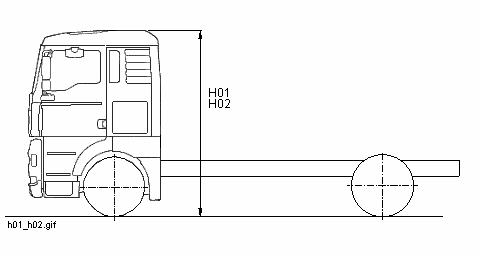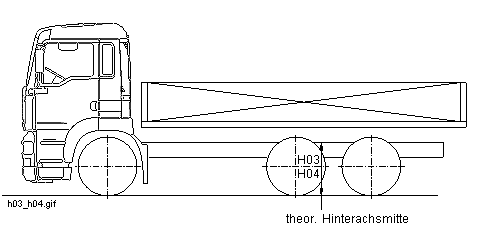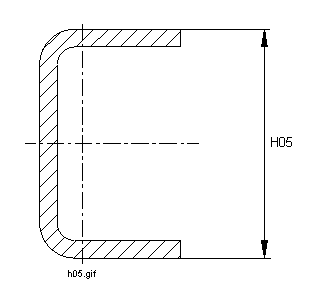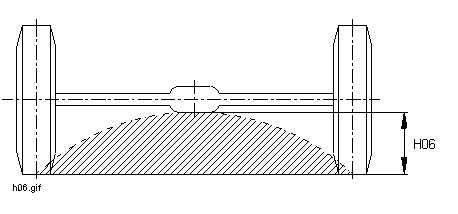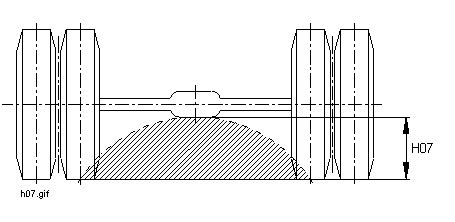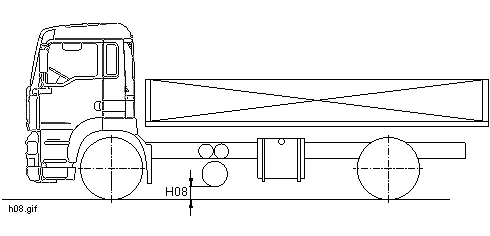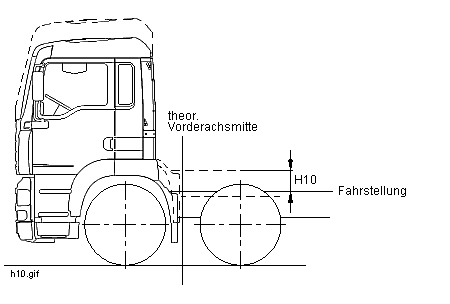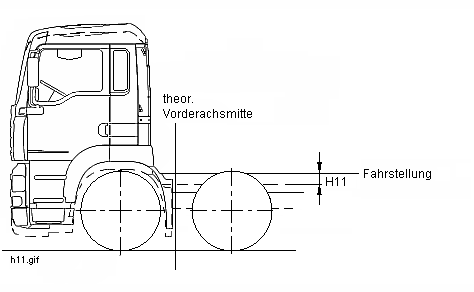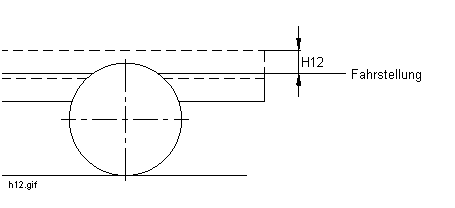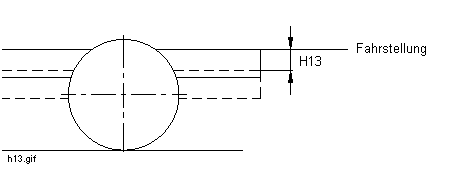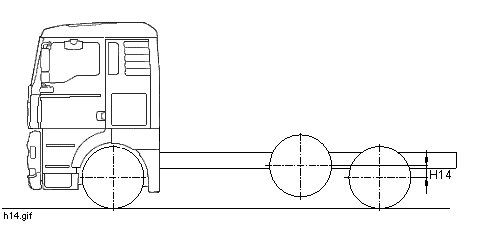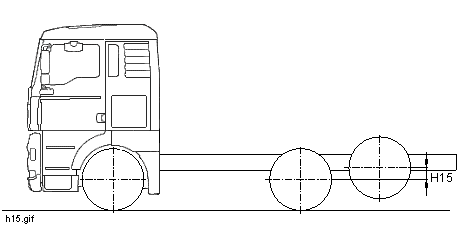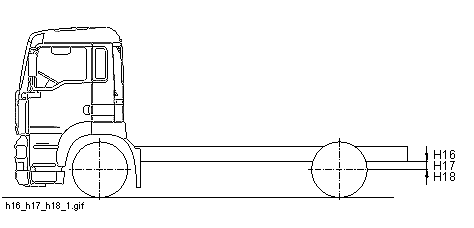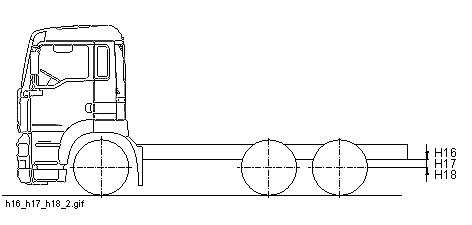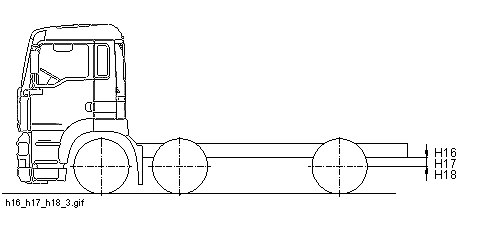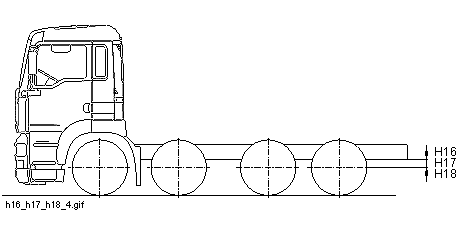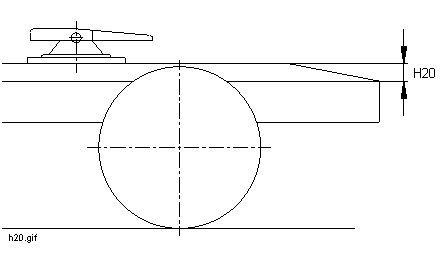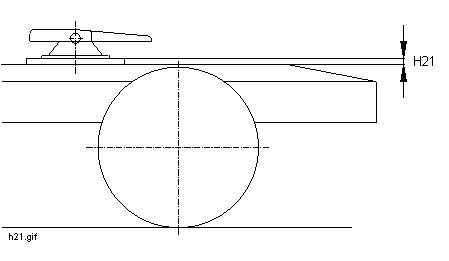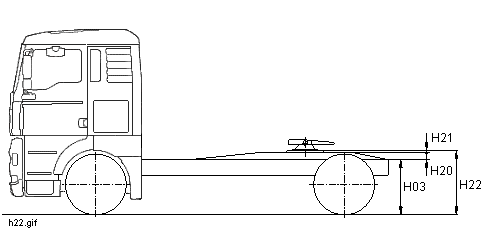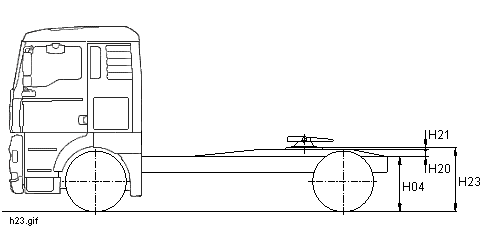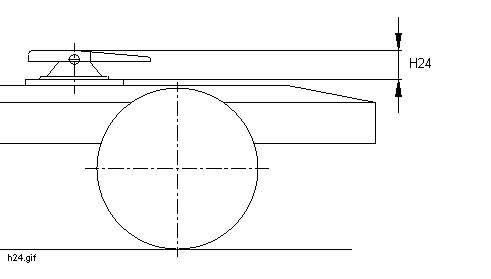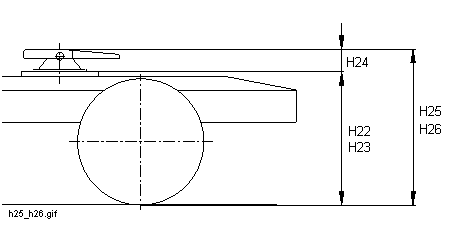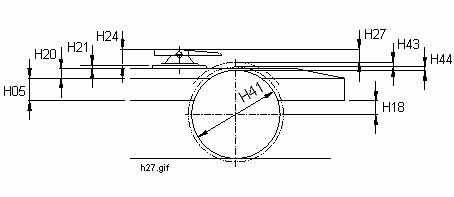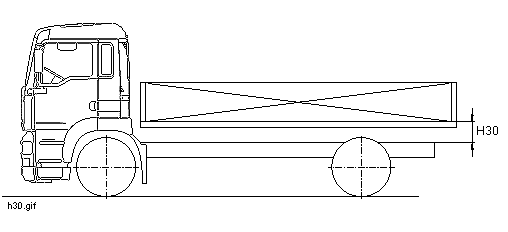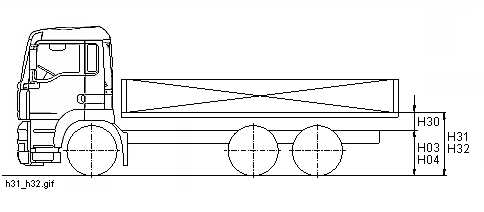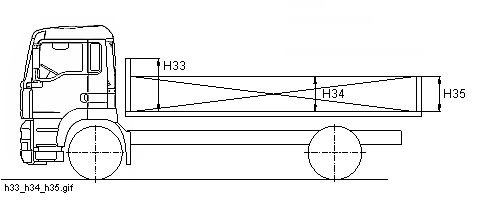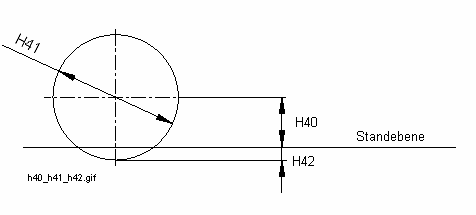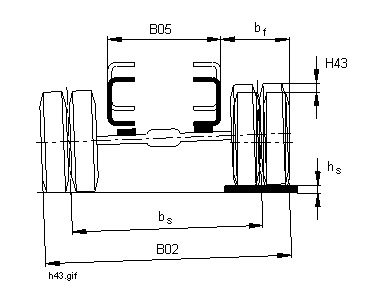- Heights
4.1 H0x: Chassis, frame heights, ground clearances
|
= |
Height above chassis unloaded |
|
|
|
|
Distance from top edge cab to ground for unloaded, but operative chassis corresponding to the definition G50 = "Chassis weight with cab". The roof flap is only considered if closed. High roof and roof spoiler are not considered. The measure H01 and the presentation are independent of the number of axles. |
|
= |
Height above chassis loaded |
|
|
|
|
Distance from top edge cab to ground in loaded state. The chassis is loaded up to G49 = "Permitted total weight according to the chassis drawing". The roof flap is only considered if closed. High roof and roof spoiler are not considered. The measure H02 and the presentation are independent of the number of axles. |
|
|
|
|
|
= |
Frame height unloaded |
|
|
|
|
Distance from top edge of the frame to the ground, possibly prescribed subframe is not considered. The vehicle has the weight state G50 = "Chassis weight with cab". The measure refers to the theoretical rear axle centre, definition theoretical axle centres see Measures and weights. The measure H03 and the presentation are independent of the number of axles. |
|
= |
Frame height loaded |
|
|
|
|
Distance from top edge of the frame to ground, possibly prescribed subframe is not considered. The vehicle has the weight state G50 = "Chassis weight with cab". The measure refers to the theoretical rear axle centre, definition theoretical axle centres see Measures and weights. The chassis is loaded up to G49 = "Permitted total weight according to the chassis drawing". The measure H04 and the presentation are independent of the number of axles. |
|
|
|
|
|
= |
Frame rail profile heights outside |
|
|
|
|
Data origin: profile database |
|
|
|
|
|
= |
Ground clearance in the front |
|
|
|
|
Ground clearance below an axle in loaded state according to DIN 70020. For more than one axle of an front axle group the lowest measure is indicated. The measure H06 and the presentation are independent of the number of axles. |
|
|
|
|
|
= |
Ground clearance behind |
|
|
|
|
Ground clearance below an axle in loaded state according to DIN 70020. For more than one axles of a rear axle group the lowest measure is indicated. The measure H07 and the presentation are independent of the number of axles. |
|
|
|
|
|
= |
Ground clearance between the axles |
|
|
|
|
Lowest point of components between front and rear axle(s) in loaded state according to DIN 70020. Axles and axle location components are not counted among. The measure H08 and the presentation are independent of the number of axles. |
|
|
|
|
4.2 H1x: Lift and lower
|
= |
Lift from driving position in the front |
|
|
|
|
Is only applied for vehicles with air suspension axle(s). Measure from driving position to the highest lifted position measured at the point of the theoretical front axle centre, definition see Measures and weights. Tyre compressions and rebounds are not considered. The measure H10 and the presentation are independent of the number of axles. |
|
|
|
|
|
= |
Lower from driving position in the front |
|
|
|
|
Is only applied for vehicles with air suspension axle(s). Measure from driving position to the lowest lowered position measured at the point of the theoretical front axle centre, definition see Measures and weights. Tyre compressions and rebounds are not considered. The measure H11 and the presentation are independent of the number of axles. |
|
|
|
|
|
= |
Lift from driving position behind |
|
|
|
|
Is only applied for vehicles with air suspension axle(s). Measure from driving position to the highest lifted position measured at the point of the theoretical rear axle centre. Definition see Measures and weights. Tyre compressions and rebounds are not considered. The measure H12 and the presentation are independent of the number of axles. |
|
|
|
|
|
= |
Lower from driving position behind |
|
|
|
|
Is only applied for vehicles with air suspension axle(s). Measure from driving position to the lowest lowered position measured at the point of the theoretical rear axle centre, definition see Measures and weights. Tyre compressions and rebounds are not considered. The measure H13 and the presentation are independent of the number of axles. |
|
|
|
|
|
= |
Lift the leading axle |
|
|
|
|
The wheels of lifted axles can rise more over the upper edge of the frame than wheels of air suspension axles in the lowered state. The measure H14 and the presentation are independent of the number of axles. |
|
|
|
|
|
= |
Lift the trailing axle |
|
|
|
|
The wheels of lifted axles can rise more over the upper edge of the frame than wheels of air suspension axles in the lowered state. The measure H15 and the presentation are independent of the number of axles. |
|
|
|
|
|
= |
Wheel centre to lower edge of the frame unloaded |
|
|
|
|
Distance from the measure relevant wheel centre tothe lower edge of the frame. With measure relevant wheel centre is meant: 4x2/2 2. axle 4x4/2 " 6x2/2 " 6x2-4 " 6x4-4 " 6x6-4 " 6x2/4 3. axle 6x4/2 " 6x4/4 " 6x6/2 " 8x2-6 " 8x4-6 " 8x8-6 " 8x2/4 4. axle 8x4/4 " 8x6/4 " 8x8/4 " For five- and six-axle vehicles the measure relevant wheel centre is to determine according to the design. |
|
= |
Wheel centre to lower edge of the frame loaded |
|
|
|
|
Corresponds to the measure in loaded state up to the permitted loads according to the chassis drawing. |
|
= |
Wheel centre to lower edge of the frame stop |
|
|
|
|
Corresponds to the measure from the according chassis drawing
|
|
|
|
|
|
|
|
|
|
|
|
|
|
|
|
|
4.3 H2x: Fifth-wheel measures
|
= |
Fifth-wheel subframe |
|
|
|
|
Height of the fifth-wheel subframe measured from top edge of the frame to top edge of the subframe. The measure H20 and the presentation are independent of the number of axles. |
|
|
|
|
|
= |
Fifth-wheel coupling mounting plate |
|
|
|
|
Height of the mounting plate which derves for the installation of the fifth-wheel coupling. The measure H21 and the presentation are independent of the number of axles. |
|
|
|
|
|
= |
Fifth-wheel height without coupling unloaded |
|
|
|
|
Height from the ground to the top edge of the fifth-wheel coupling mounting plate in unloaded state. The installation height of the fifth-wheel coupling must be added, because the fifth-wheel coupling not belongs to the standard scope of delivery. On demand several installation heights are deliverable. The measure H22 and the presentation are independent of the number of axles. |
|
|
|
|
|
= |
Fifth-wheel height without coupling loaded |
|
|
|
|
Height from the ground to the top edge of the fifth-wheel coupling mounting plate in loaded state. The installation height of the fifth-wheel coupling must be added, because the fifth-wheel coupling not belongs to the standard scope of delivery. On demand several installation heights are deliverable. The measure H23 and the presentation are independent of the number of axles. |
|
|
|
|
|
= |
Installation height of the fifth-wheel coupling |
|
|
|
|
The fifth-wheel coupling belongs not in each case to the standard scope of delivery. To calculate H25 = "Fifth-wheel height unloaded above ground" and H26 = "Fifth-wheel height loaded above ground", the assumed installation height of the fifth-wheel coupling is indicated. The measure H24 and the presentation are independent of the number of axles. |
|
|
|
|
|
= |
Fifth-wheel coupling loaded above ground |
|||
|
Top edge of the fifth-wheel coupling in unloaded state G50 = "Chassis weight with cab" to ground and under consideration of H22 = "Fifth-wheel height without coupling unloaded" and H24 = "Installation height of the fifth-wheel coupling". The measure H25 and the presentation are independent of the number of axles. |
||||
|
= |
Fifth-wheel coupling loaded above ground |
|
|
|
|
Top edge of the fifth-wheel coupling in loaded state G09 = "Permitted total weight" to ground and under consideration of H23 = "Fifth-wheel height without coupling unloaded" and H24 = "Installation height of the fifth-wheel coupling". The measure H26 and the presentation are independent of the number of axles. |
|
|
|
|
|
= |
Top edge of the tyre to fifth-wheel coupling lowered |
|
|
|
|
Top edge of the tyre to top edge fifth-wheel coupling in lowered state at air suspension. At leaf suspension the stop measure of the suspension is valid. The measure H27 and the presentation are independent of the number of axles. |
|
|
|
|
4.4 H3x: Load deck measures
|
= |
Substructure height series |
|
|
|
|
Measure from top edge of the frame to top edge of the platform ground of the standard platform. A lower substructure height is possible, if H43 = "Tyre clearance", gearbox clearance etc. is warranted. The measure H30 and the presentation are independent of the number of axles. |
|
|
|
|
|
= |
Loading platform height unloaded |
|
|
|
|
Measure from the ground to the top edge of the platform ground at weight according to G50 = "Chassis weight with cab". The measure indication is valid for the range of the theoretical rear axle centre, definition see Measures and weights. H31 is only calculated, if H30 = "Substructure height series" is available. The measure H31 and the presentation are independent of the number of axles. |
|
= |
Loading platform height loaded |
|
|
|
|
Measure from the ground to the top edge of the platform ground at load up to the permitted weights, see G50 until G59. The measure indication is valid for the range of the theoretical rear axle centre, definition see Measures and weights. H32 is only calculated, if H30 = "Substructure height series" is available. The measure H32 and the presentation are independent of the number of axles. |
|
|
|
|
|
= |
Front plate height series |
|
|
|
|
Height of the front plate of the series platform. The measure H33 and the presentation are independent of the number of axles. |
|
= |
Side plate height series |
|
|
|
|
Height of the sideways plate of the series platform. The measure H34 and the presentation are independent of the number of axles. |
|
= |
Rear plate height series |
|
|
|
|
Height of the rear plate of the series platform. The measure H35 and the presentation are independent of the number of axles. |
|
|
|
|
4.5 H4x: Tyres and wheel
|
= |
Rstat Wheels |
|
|
|
|
Static radius of the tyre = Distance from the wheel centre to the stand plain; see fig. H42. The measure H40 and the presentation are independent of the number of axles. |
|
= |
External diameter of tyres |
|
|
|
|
Is valid for new tyres. Basic size according to the contact surface centre, construction measure. The measure H41 and the presentation are independent of the number of axles. |
|
= |
Tyre compression |
||||
|
|
|
The tyre compression is the distance, at which the tyre is impressed under load at standing vehicle. At assumption of the tyre spring rate as constant the tyre suspension can be calculated approximately under each arbitrary load. Example: |
|||
|
|
|
Tyre equipment |
Size |
315/80 R 22.5 |
|
|
|
|
External diameter |
H41 = |
1096 |
mm |
|
|
|
Static radius |
H40 = |
500 |
mm |
|
|
|
Permitted axle load for single fitment |
G01 = |
8000 |
kg |
|
|
|
Tyre inflation pressure |
|
8,0 |
bar |
|
|
|
If a lower permitted axle load, e.g. G01 = 7500 kg is caused at equal permitted tyre inflation pressure, the new spring travel is also calculated.
Because at G01 = 7500 kg a lower tyre inflation pressure is required, namely 7,5 bar, the height difference is approximately balanced. |
|||
|
|
|
|
|||
|
= |
Tyre clearance of the wheel |
|||
|
|
|
At checking of the tyre clearance ca. 40 mm shoould be considered as safe distance. |
||
|
|
|
Example: Assumptions on the basis of drawing-nr. 81.99126.8192 |
||
|
|
|
Track at twin-fitted driving axle bS One-sided lifting of the axle (stage) at lowered axle until stop. Leaf and air suspension are identic hS |
= = |
1802 mm 100 mm |
|
|
|
Askew stand angle of the axle
Distance from tyre outer edge to frame = pivotal point of the axle at askew standing. There is assumed, that the tyre outer edge lies ca. 50 mm within the width over rear tyres (= B02), as it is 100 mm smaller than B02.
Clearance:
In practice H43 = 40 mm is chosen. |
||
|
|
|
|
||
|
= |
Dynamic dimension anti-skid chains |
||
|
|
|
The dynamic dimension is the measure which arises during the drive at permitted driving speed with chains, because of the centrifugal force. The dynamic dimension must not be confused with the installed height. The installed height is measured at standing vehicle and is considerably lower, partly lower as the half of the dynamic dimension. The measures of the anti-skid chains depend on
If the dynamic dimension for anti-skid chains is to consider, the following measures are recommended: |
|
|
|
|
Rims 17,5 19,5 22,5 |
H44 70 80 80 |
|
|
|
Within the technical data the dynamic dimension of the anti-skid chains is not considered. |
|
